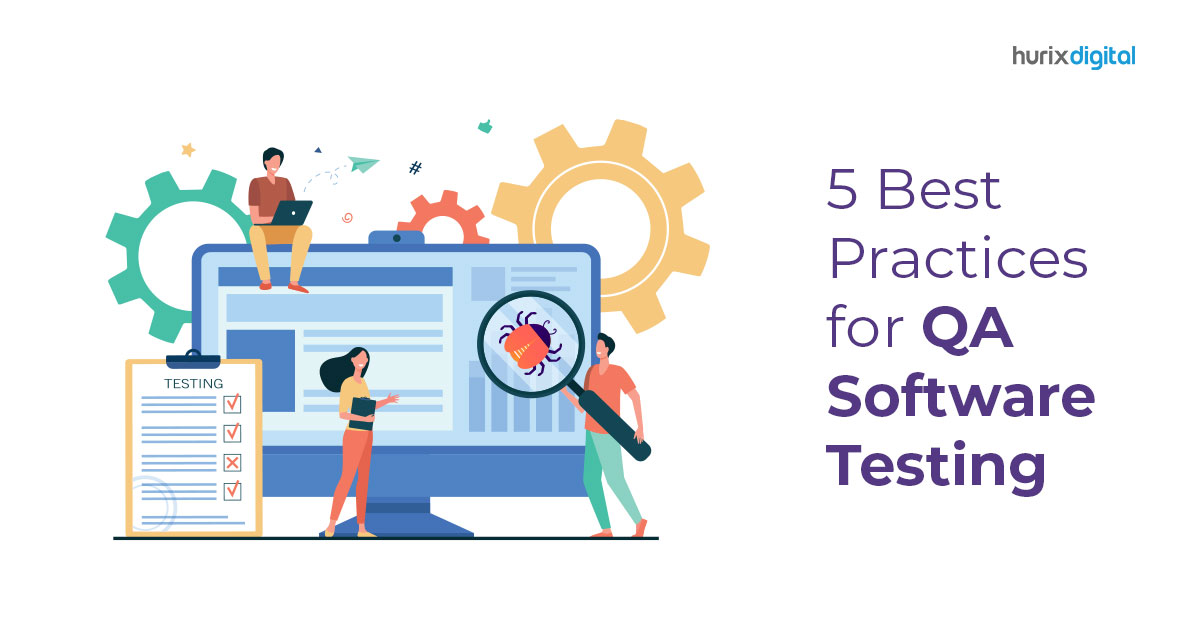
5 Best Practices for QA Software Testing
Summarize with:
You’ve probably seen it all. Not only the software bugs but also when those bugs are out in production and no one knows they’re there.
We’ve all been there. You might be testing software on time or a new feature and discover a bug that would have cost you thousands more if you didn’t find it before then. Or what about that time when you found an error that would have caused people to lose their files if they hadn’t been tested right away?
QA software testing can help save time, energy, and resources while providing your end users a better experience. With this in mind, here are five best practices that will help you avoid some common pitfalls:
1. Design Test Cases
It’s no secret that there are a lot of different ways to design test cases. Some people like to use the “more is better” approach, while others prefer a more streamlined approach.
One of the best ways to go about this is to design test cases to cover all the possible scenarios.
As the name suggests, this approach involves covering all possible scenarios in your software testing process. If you can, think of any possible scenario that could happen with your application or product – like what would happen if someone clicked on the “delete all saved documents” button without having any documents saved? – then try adding this as part of your design documentation.
2. Effective QA Software Testing
So, you’ve got some deep, powerful tests. Nice work! Now it’s time to make sure they’re as effective as they need to be.
To do this, you’ll want to create more such tests. This can mean adding more cases or rules based on what has already been built into the system and tested or adding new elements altogether (like a live user interface).
In addition to expanding this list of known behaviors in your application under test, it’s also important that you keep an eye out for red flags. New bugs that can crop up during testing are a clear indication that something is wrong with your current approach.
If you don’t find any bugs after running through our original set of tests again, you should probably go back over them one more time before moving on to something else entirely!
3. Get Your Hands On Production Data
You’ll need to work with the developers and operations team to get your hands on production data.
They can help you understand what kind of data is available and how to access it. Begin by asking questions about the environment you’ll be working within (e.g., test or production), how much time you have to do testing, and whether there are any security restrictions on accessing certain information.
The type of information that can be useful for validation varies based on what industry your company is in, but here are a few examples:
- End-user experiences with an application or service.
- Customer feedback from surveys or support calls.
- Business metrics from financial reports.
4. Create A List Of Negative Scenarios
To ensure your quality assurance software testing is getting the most out of the time you’re putting in, it’s important to set some goals.
In particular, you should create a list of negative scenarios – that is, what could go wrong with your software?
Usually, when we write about “negative” things, we mean them as bad things. But as far as QA testing goes, it’s helpful to think about how something might not work or how people might abuse it if they want to cause harm or damage through their actions.
The goal here is to get into the mindset of someone who wants to break down and exploit your product to use it for malicious purposes. If there are any holes in your system or errors in code that could potentially be misused (such as a password reset feature), this is where you’ll find them!
5. Create Priority Lists While QA Software Testing
While testing, there are plenty of factors that contribute to the quality control measures you have. You want to follow a systematic approach where you make a list of the points to keep in mind while testing, such as:
- Test the application on different browsers and devices.
- Test the application on different operating systems.
- Test the application on different internet connections (Wifi, 3G, 4G, etc.).
- Test the application on different network conditions (low signal strength, high CPU usage, etc.).
- Test if there is any impact of these factors on the overall performance of your software during real-time testing.
6. Efficient Multitasking
To be successful at QA software testing, you need to be able to multitask. This ensures that you maximize efficiency while trying to carry out complex tests and attempt to navigate different scenarios.
The unfortunate reality is that it’s easy to get distracted by other things. You may have a lot of other tasks which require priority attention and firefighting, and that’s normal!
But if you’re not careful, your mind will wander away from the task at hand, and you’ll lose focus on what matters most – getting those bugs out of the system for good.
It can be tough not to let outside factors enter into our daily lives, but if we can learn how to prioritize tasks, then we won’t be pulled away from our QA objectives as easily.
Also read, how QA services can improve your business competitiveness.
Hurix’s QA Software Testing
If you’re looking for a dedicated QA engineer who can help you test your application, then look no further than Hurix. We can provide you with the best possible service without breaking the bank.
The Hurix team has a team of experienced QA software testing engineers who are dedicated to your project. Our QA engineers are certified and have experience in different domains. We are glad to have helped you with your QA software testing needs.
For any further assistance or in case you have any questions, please don’t hesitate to reach out to us at Hurix’s QA Testing Team. We will be more than happy to help!
Summarize with:

 A Space for Thoughtful
A Space for Thoughtful 